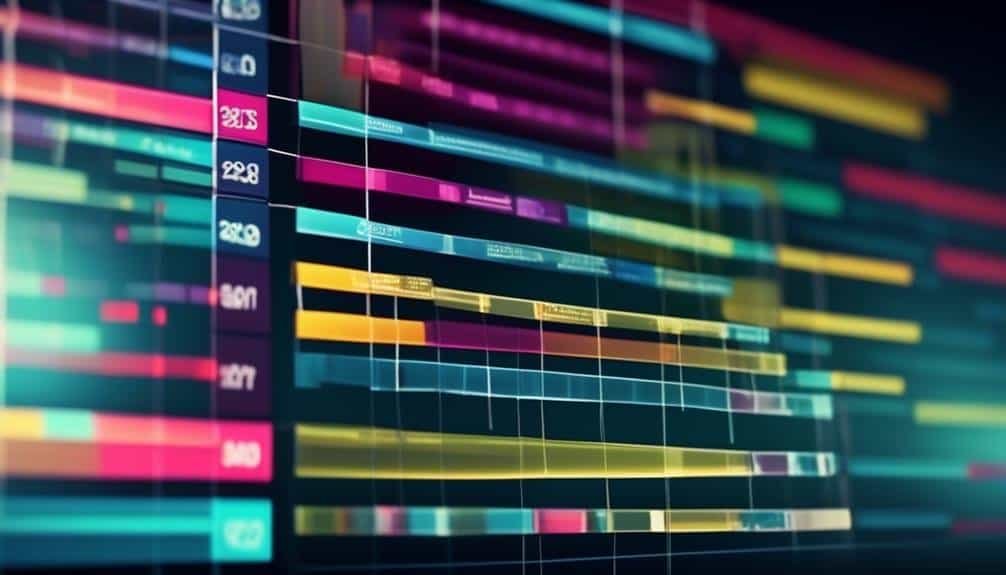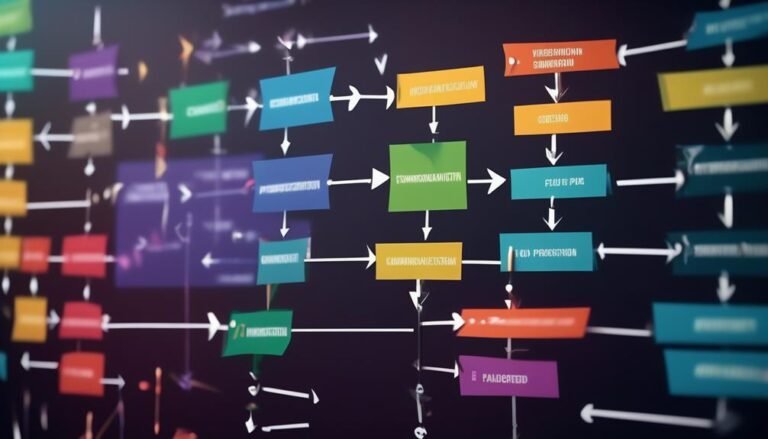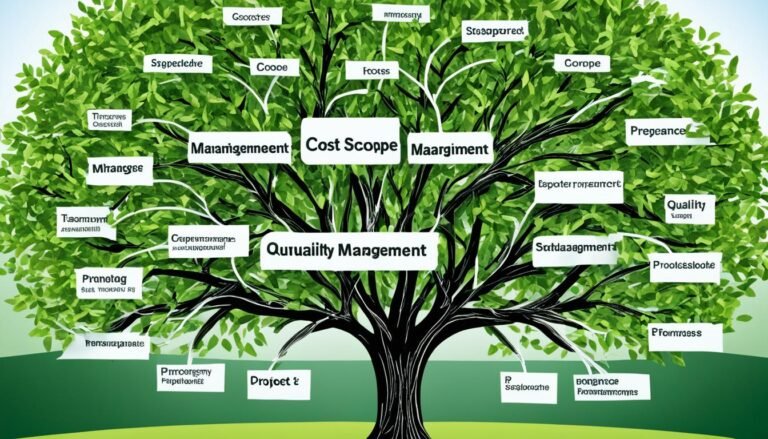Gantt Charts: Visualizing Your Project Timeline
In today's fast-paced business environment, efficient project management is pivotal to the success of any organization. One tool that has gained popularity for its ability to streamline project planning and execution is the Gantt chart.
This visual representation of a project timeline allows teams to effectively allocate resources, track progress, and manage dependencies. But what exactly are Gantt charts, and how can they benefit your projects?
In this discussion, we will explore the basics of Gantt charts, delve into their advantages, and provide valuable tips for creating and utilizing them effectively.
So, whether you're a project manager seeking to enhance your team's productivity or a business owner looking to improve project outcomes, read on to discover how Gantt charts can revolutionize your project management practices.
Key Takeaways
- Gantt charts are visual tools used to represent project timelines, tasks, durations, and dependencies.
- They help identify bottlenecks, overlaps, and gaps in the project plan, facilitating better communication and collaboration within a team.
- Gantt charts enhance team collaboration, accountability, and provide transparency and ownership of tasks.
- They help prioritize tasks, allocate resources effectively, and identify potential bottlenecks and delays in the project.
What Are Gantt Charts?
A Gantt chart is a visual tool used to represent project timelines, providing a clear and organized overview of tasks, their durations, and their dependencies. Gantt charts are widely utilized in project planning due to their numerous advantages.
Firstly, they offer a visual representation of the project schedule, allowing project managers and team members to easily understand the timeline and progress of the project. This visual representation helps in identifying potential bottlenecks, overlaps, and gaps in the project plan.
Additionally, Gantt charts facilitate effective communication and collaboration within the project team, as they provide a common reference point for all stakeholders.
Furthermore, Gantt charts enable project managers to allocate resources efficiently by identifying task dependencies and critical paths. By visualizing these dependencies, project managers can better manage resources, assign tasks, and avoid potential delays.
Moreover, Gantt charts assist in setting realistic project deadlines and milestones, as they provide a comprehensive view of task durations and dependencies.
Benefits of Using Gantt Charts
Gantt charts offer numerous benefits to project managers and teams in effectively managing tasks and timelines. They play a crucial role in project planning and execution by providing a visual representation of the project's timeline, dependencies, and progress. By using Gantt charts, project managers can prioritize tasks, allocate resources, and identify potential bottlenecks or delays.
One of the key advantages of Gantt charts is that they enhance team collaboration. By clearly outlining the project's timeline and individual tasks, team members can easily understand their responsibilities and deadlines. This promotes transparency and accountability within the team, ensuring that everyone is on the same page and working towards a common goal. Additionally, Gantt charts allow team members to see how their tasks fit into the overall project, fostering a sense of ownership and motivation.
Furthermore, Gantt charts facilitate effective communication between project managers and stakeholders. By visualizing the project's timeline and progress, project managers can easily update stakeholders on the project's status and any changes in the schedule. This helps in managing expectations and ensuring that everyone is informed and aligned.
Tips for Creating Effective Gantt Charts
To effectively create Gantt charts, project managers should follow a set of guidelines that ensure clarity and accuracy in representing project timelines and dependencies. Creating engaging Gantt charts can greatly improve project planning and communication. Here are some tips to create effective Gantt charts:
- Define project tasks: Break down the project into specific tasks and identify their dependencies. This will help in accurately representing the project timeline.
- Set realistic deadlines: Assign start and end dates to each task based on their dependencies and estimated durations. Be realistic and consider potential delays or dependencies on external factors.
- Use appropriate symbols and colors: Utilize different symbols or colors to represent different types of tasks, such as milestones, critical tasks, or recurring tasks. This visual distinction will make it easier to understand the chart at a glance.
- Include task details: Provide relevant information about each task, such as task owners, resources required, and task descriptions. This will help project team members understand their responsibilities and the scope of each task.
- Update regularly: Keep the Gantt chart up to date by regularly updating task progress, deadlines, and any changes in dependencies. This will help in tracking the project's progress and making necessary adjustments.
How to Utilize Gantt Charts for Project Management
Effective utilization of Gantt charts in project management enhances planning, coordination, and monitoring of tasks and timelines. Gantt charts provide a visual representation of project schedules, allowing project managers to easily track progress and identify potential bottlenecks. To effectively utilize Gantt charts, project managers can consider the following strategies:
- Identify project tasks: Break down the project into smaller tasks and list them in the Gantt chart. This helps in creating a clear roadmap of the project.
- Set dependencies: Determine the sequence of tasks and their dependencies. This ensures that tasks are completed in the correct order and helps in managing project timelines.
- Allocate resources: Assign resources to each task, including team members, equipment, and budget. This helps in resource management and ensures that all necessary resources are available when needed.
- Monitor progress: Regularly update the Gantt chart with the progress of each task. This provides a real-time view of the project's status and helps in identifying any delays or issues.
- Integrate with project management software: Utilize project management software that supports Gantt charts, such as Microsoft Project or Asana. This allows for seamless integration of tasks, timelines, and resources, making project management more efficient.
Gantt charts can be used in various industries, including construction, software development, marketing, and event planning. Here are some examples of how Gantt charts can be applied:
| Industry | Gantt Chart Use |
|---|---|
| Construction | Tracking construction activities and deadlines |
| Software | Managing software development milestones |
| Marketing | Planning and executing marketing campaigns |
| Event planning | Coordinating tasks for event preparation |
Best Practices for Tracking Progress With Gantt Charts
Tracking progress with Gantt charts is a crucial aspect of effective project management. Gantt charts provide a visual representation of project tasks, timelines, and dependencies, allowing project managers to monitor progress and make informed decisions. To effectively track progress using Gantt charts, it is important to follow best practices and use appropriate tracking methods.
One of the best practices for tracking progress with Gantt charts is to regularly update and maintain the chart. This involves recording actual start and end dates, as well as any changes to task durations or dependencies. By keeping the Gantt chart up to date, project managers can accurately track progress and identify any delays or issues that may arise.
Another best practice is to use milestones or checkpoints in the Gantt chart. These are specific points in the project where progress can be measured and evaluated. Milestones help project managers track progress against the project schedule and ensure that tasks are completed on time.
Additionally, it is important to use clear and concise task descriptions in the Gantt chart. This allows team members to easily understand their responsibilities and deadlines.
Moreover, project tracking should be done in real-time, ensuring that project managers have access to the most current information and can make timely decisions.
Conclusion
In conclusion, Gantt charts are an invaluable tool for visualizing project timelines and effectively managing projects.
By eliminating personal pronouns, we can focus on the objective benefits of using Gantt charts, such as improved organization, increased efficiency, and better resource allocation.
Just as a compass guides a lost traveler, Gantt charts navigate project managers through the complexities of their tasks, providing a clear path towards success.






